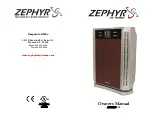
12
en
* The figure to the left is an example
only. The stop valve shape, service port
position, etc., may vary according to the
model.
* Turn section
A
only.
(Do not further tighten sections
A
and
B
together.)
C
Charge hose
D
Service port
Precautions when using the charge valve (Fig. 4-13)
Do not tighten the service port too much when installing it, otherwise, the valve core
could be deformed and become loose, causing a gas leak.
After positioning section
B
in the desired direction, turn section
A
only and tighten it.
Do not further tighten sections
A
and
B
together after tightening section
A
.
Fig. 4-13
4. Installing the refrigerant piping
4.6. Refrigerant pipe airtight testing method
(1) Connect the testing tools.
• Make sure the stop valves
A
B
are closed and do not open them.
• Add pressure to the refrigerant lines through the service port
C
of the liquid
stop valve
A
and the gas stop valve
B
.
(2) Do not add pressure to the specified pressure all at once; add pressure little by little.
1
Pressurize to 0.5 MPa (5 kgf/cm
2
G), wait five minutes, and make sure the
pressure does not decrease.
2
Pressurize to 1.5 MPa (15 kgf/cm
2
G), wait five minutes, and make sure the
pressure does not decrease.
3
Pressurize to 4.15 MPa (41.5 kgf/cm
2
G) and measure the surrounding tem-
perature and refrigerant pressure.
(3) If the specified pressure holds for about one day and does not decrease, the pipes
have passed the test and there are no leaks.
• If the surrounding temperature changes by 1°C, the pressure will change by
about 0.01 MPa (0.1 kgf/cm
2
G). Make the necessary corrections.
(4) If the pressure decreases in steps (2) or (3), there is a gas leak. Look for the source
of the gas leak.
4.7. Stop valve opening method
(1) Gas side (Fig. 4-11)
1
Remove the cap, pull the handle toward you and rotate 1/4 turn in a counterclock-
wise direction to open.
2
Make sure that the stop valve is open completely, push in the handle and rotate
the cap back to its original position.
(2) Liquid side (Fig. 4-12)
1
Remove the cap and turn the valve rod counterclockwise as far as it will go with
the use of a 4 mm hexagonal wrench. Stop turning when it hits the stopper.
(ø6.35: Approximately 4.5 revolutions) (ø9.52: Approximately 10 revolutions)
2
Make sure that the stop valve is open completely, push in the handle and rotate
the cap back to its original position.
A
Valve body
B
Unit side
C
Handle
D
Cap
E
Local pipe side
F
Open position side
G
Service port
H
Valve stem
I
Refrigerant flow direction
Refrigerant pipes are protectively wrapped
• The pipes can be protectively wrapped up to a diameter of ø90 before or after con-
necting the pipes. Cut out the knockout in the pipe cover following the groove and
wrap the pipes.
Pipe inlet gap
• Use putty or sealant to seal the pipe inlet around the pipes so that no gaps remain.
(If the gaps are not closed, noise may be emitted or water and dust will enter the
unit and breakdown may result.)
Fig. 4-10
(1)
1
2
Fig. 4-12
Fig. 4-11
(2)
1
2
A
Stop valve <Liquid side>
B
Stop valve <Gas side>
C
Service port
D
Open/Close section
E
Local pipe
F
Sealed, same way for gas side
G
Pipe cover
H
Do not use a wrench here.
Refrigerant leakage may result.
I
Use two wrenches here.
E
B
A
D
G
C
F
G
Warning:
• When opening or closing the valve below freezing temperatures, refrigerant
may spurt out from the gap between the valve stem and the valve body, result-
ing in injuries.
BH79D826H05.indb 12
2020/04/27 9:37:00
014












































